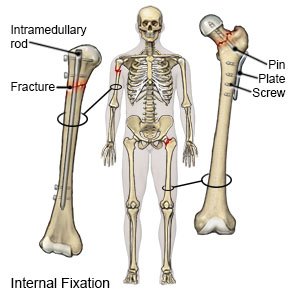Hardware Removal
Medically reviewed by Drugs.com. Last updated on Apr 6, 2025.
Hardware removal is surgery to take out devices used to hold your broken bones together while they heal. These devices may include pins, screws, plates, or wires. You may need hardware removed because you have pain or an infection. Hardware in young children may need to be removed to prevent problems with bone growth.
 |
DISCHARGE INSTRUCTIONS:
Call your local emergency number (911 in the US) if:
- You suddenly feel lightheaded and short of breath.
- You have chest pain when you take a deep breath or cough. You may cough up blood.
Call your doctor if:
- Blood soaks through your bandage.
- Your stitches come apart.
- Your arm or leg feels warm, tender, and painful. It may look swollen and red.
- You have a fever and chills.
- You have a cough or feel weak and achy.
- Your surgery area is red, swollen, or draining pus.
- You have more pain and swelling, even after you take medicine.
- You have questions or concerns about your condition or care.
Medicines:
You may need any of the following:
- Antibiotics help prevent or treat an infection caused by bacteria.
- Prescription pain medicine may be given. Ask your healthcare provider how to take this medicine safely. Some prescription pain medicines contain acetaminophen. Do not take other medicines that contain acetaminophen without talking to your healthcare provider. Too much acetaminophen may cause liver damage. Prescription pain medicine may cause constipation. Ask your healthcare provider how to prevent or treat constipation.
- Take your medicine as directed. Contact your healthcare provider if you think your medicine is not helping or if you have side effects. Tell your provider if you are allergic to any medicine. Keep a list of the medicines, vitamins, and herbs you take. Include the amounts, and when and why you take them. Bring the list or the pill bottles to follow-up visits. Carry your medicine list with you in case of an emergency.
Self-care:
- Rest often while you recover. Ask when you can return to your usual activities.
- Use support devices as directed. Crutches, a cane, or a walker will help you move around and decrease your risk for falling. Ask your healthcare provider for more information about how to use your support device.
- Go to physical therapy (PT), if directed. PT can help you learn to move safely while you heal. You may also increase range of motion and build strength.
- Keep the procedure area clean and dry. When you are allowed to bathe, carefully wash the area with soap and water. Dry the area and put on new, clean bandages as directed. Change your bandages when they get wet or dirty. Check the area for signs of infection, such as redness, swelling, or pus.
Follow up with your doctor or surgeon as directed:
You will need to return to have the surgery area checked or stitches removed. Write down your questions so you remember to ask them during your visits.
© Copyright Merative 2025 Information is for End User's use only and may not be sold, redistributed or otherwise used for commercial purposes.
The above information is an educational aid only. It is not intended as medical advice for individual conditions or treatments. Talk to your doctor, nurse or pharmacist before following any medical regimen to see if it is safe and effective for you.
Further information
Always consult your healthcare provider to ensure the information displayed on this page applies to your personal circumstances.
